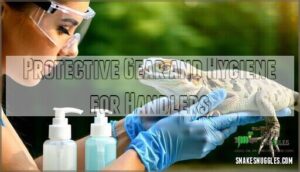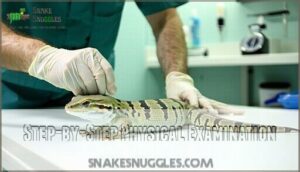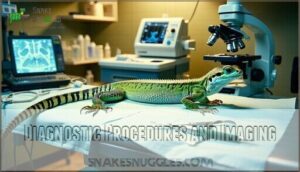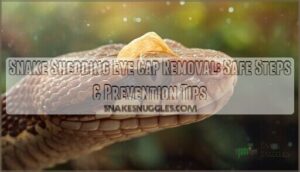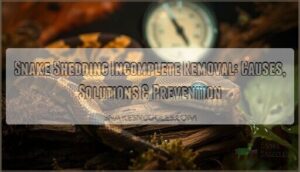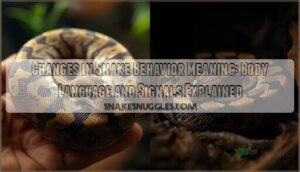This site is supported by our readers. We may earn a commission, at no cost to you, if you purchase through links.
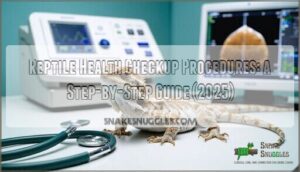
A complete reptile health checkup involves more than a quick visual assessment; it requires species-specific management protocols, diagnostic imaging, and laboratory analysis that most owners can’t perform at home. Understanding what happens during a professional examination helps you prepare effectively, recognize when your reptile needs urgent care, and partner with your veterinarian to maintain long-term wellness.
Table Of Contents
- Key Takeaways
- Preparing for a Reptile Health Checkup
- Safe Handling and Restraint Techniques
- Step-by-Step Physical Examination
- Diagnostic Procedures and Imaging
- Advanced Care and Ongoing Wellness
- Frequently Asked Questions (FAQs)
- Do Reptiles need a health check?
- How often should a veterinarian check a pet reptile?
- How do I choose a veterinarian for my reptile?
- What should be considered when performing a reptile surgery?
- How are reptiles restrained for physical examination?
- Why do Reptiles need a veterinarian?
- What blood tests are commonly performed on reptiles?
- How often should reptiles have fecal screenings?
- Can reptiles receive pain medication after procedures?
- What signs indicate my reptile needs emergency care?
- Conclusion
Key Takeaways
- Reptiles hide illness as a survival mechanism, making professional veterinary exams with diagnostic imaging and lab work essential since visual assessment alone misses life-threatening problems until they’re advanced.
- Finding a qualified reptile veterinarian requires verifying specialized credentials like ARAV membership and board certification in reptile medicine, not just a general DVM degree, since most practitioners lack the training for accurate exotic species diagnosis.
- A complete reptile health checkup follows a systematic head-to-tail protocol combining physical examination, behavioral observation, parasite screening, and diagnostic imaging to establish baseline health metrics that reveal subtle changes over time.
- Annual veterinary checkups shift reptile care from reactive crisis management to proactive disease prevention, catching metabolic disorders, parasites, and organ dysfunction before clinical symptoms emerge and treatment becomes difficult.
Preparing for a Reptile Health Checkup
Getting ready for your reptile’s vet visit actually begins at home. Gather up your pet’s history, habitat details, and care routine before you head out—your vet will need this information to do a proper exam.
These three steps will set your vet up to give your reptile a complete checkup.
Gathering Medical History and Enclosure Information
Before your reptile’s first vet appointment, gather three key things: your pet’s medical history, details about their enclosure setup, and any behavior changes you’ve noticed lately.
Having this information ready helps your vet do a complete exam that’s specific to your animal’s needs.
Your preparation checklist should include:
- Medical records documenting previous treatments, medications, and any health concerns since acquisition
- Environmental assessments noting temperature gradients, humidity levels, substrate type, and UV lighting specifications
- Dietary evaluations listing prey size, feeding frequency, and any recent appetite changes
- Habitat analysis describing enclosure dimensions, hide boxes, water sources, and cage mates
What you tell your vet about your reptile’s daily care directly shapes how thorough and useful the examination will be.
Choosing a Qualified Reptile Veterinarian
Once you’ve organized your reptile’s records, finding the right veterinary care becomes your next priority. Not all veterinarians are comfortable managing reptiles, and general practitioners often lack the specialized training required for effective reptile medicine. Start by checking for veterinary credentials—a Doctor of Veterinary Medicine (DVM) from an accredited college is mandatory, but you’ll want more than baseline qualifications.
Look for veterinarians with proven reptile expertise. Ask about their clinical experience with your species, continuing education hours, and whether they’ve completed internships or residencies focused on exotic animals. Board certification in reptile and amphibian medicine represents the highest standard—only 19 veterinarians in the U.S. held this credential as of December 31, 2024—but accreditation standards vary by practice.
Professional memberships matter. Veterinarians affiliated with the Association of Reptile and Amphibian Veterinarians (ARAV) demonstrate commitment to reptile health. You can also verify their USDA National Veterinary Accreditation Program (NVAP) status if you’ll need interstate health certificates.
| Credential Type | What It Indicates | How to Verify |
|---|---|---|
| DVM Degree | Basic veterinary education from accredited institution | State licensing board databases |
| Board Certification | Advanced specialization in reptile/amphibian medicine | ARAV or specialty college directories |
| ARAV Membership | Professional commitment to reptile veterinary care | ARAV member directory |
| NVAP Accreditation | Authority to issue official health certificates | USDA APHIS online registry |
| State License | Current legal authorization to practice veterinary medicine | State veterinary medical board websites |
Don’t hesitate to ask direct questions about a veterinarian’s qualifications before booking. Client reviews can provide insight, but they shouldn’t replace verification of accreditation standards. Practices near universities or zoological institutions often have stronger reptile expertise due to teaching hospital affiliations. It’s essential to research exotic animal care to find the best veterinarian for your reptile.
Initial consultation fees range from $85 to $250 depending on specialization and location—board-certified specialists may charge double what general practitioners do, but you’re paying for expertise that can make the difference in accurate diagnosis. Metropolitan areas offer more options; if you’re in a rural location, you may need to travel for qualified veterinary care.
Safe Transport and Handling to The Clinic
Getting your reptile to the clinic safely requires planning that starts the moment you schedule the appointment. Vehicle preparation includes temperature control and secure carrier placement—never leave reptiles in hot or cold vehicles.
Follow these reptile capture and restraint techniques:
- Select species-appropriate reptile carriers with ventilation and no escape routes
- Minimize transport stress by keeping the carrier dark and stable
- Arrive at the clinic with enclosure photos and fecal samples ready
Proper animal management and owner education about reptile care and management guarantee your pet receives peak veterinary care for reptiles.
Safe Handling and Restraint Techniques
Your vet can’t dive into a proper exam until they’ve figured out how to handle your reptile safely.
That means reading its behavior first and picking the right restraint method—some species are calm enough for bare hands, while others need towels, gloves, or even sedation to keep everyone safe.
Some species tolerate hands-on assessment easily, while others require towels, gloves, or even sedation to protect both the animal and the caretaker.
Here’s what you need to know about temperament evaluation, restraint options, and protecting yourself during the process.
Assessing Reptile Temperament Before Handling
Before you reach for your reptile ahead of a vet visit, take a moment to watch from a distance. Their body language tells you everything you need to know about their current state of mind.
Look for defensive postures, quick tongue flicks, or any sign they’re backing away—these are your cues that handling right now carries risk. This quick assessment helps both you and the vet figure out the gentlest way to proceed with the exam.
Keep an eye out for defensive postures, rapid tongue flicking, or any backing away—these behaviors tell you handling might be risky right now.
This quick read on temperament helps you and your vet figure out the best way to restrain your reptile while keeping stress levels down during the exam.
Physical Vs. Chemical Restraint Methods
Once you’ve sized up your reptile’s temperament, the next call you’ll make is whether to restrain physically or reach for sedation—and getting this choice right can mean the difference between a smooth procedure and an exhausting ordeal for everyone involved.
Physical restraint works well for routine procedures—a towel wrap for nervous snakes or clear containers for skittish lizards keep both your reptile and caregivers safe during basic physical examination.
Chemical sedation becomes necessary when:
- Your reptile shows aggressive defensive behaviors that risk injury
- Invasive procedures require complete immobility and anesthesia
- Temperament assessment reveals extreme stress with manipulation
- Minor procedures would otherwise demand excessive physical force
- Time-sensitive diagnostics can’t wait for calming techniques
Propofol or alfaxalone administration provides rapid, controlled induction when sedation proves essential for animal safety and proper reptile care.
Protective Gear and Hygiene for Handlers
Even with the gentlest restraint technique mastered, caretakers still need a barrier between themselves and the claws, teeth, and bacterial hitchhikers that come standard with every reptile patient. Glove selection protects against scratches and reptile-borne zoonoses like Salmonella—a concern with any animal management scenario.
Long sleeves, eye protection during aggressive encounters, and strict hand sanitizing after reptile care form your hygiene protocols against zoonotic diseases while keeping protective clothing practical enough you’ll actually wear it.
Step-by-Step Physical Examination
During a physical exam, your vet starts at the head and works methodically down to the tail.
This head-to-tail approach catches subtle signs of illness or injury you might miss otherwise.
Your veterinarian will combine visual assessment with hands-on techniques to build a complete picture of your reptile’s health.
Systematic Head-to-Tail Assessment
When examining your reptile, work systematically from head to tail—this way, you won’t miss anything important.
Start with an eye examination for clarity and discharge, then proceed to a mouth assessment, checking mucous membranes and dental health.
Continue down the body, evaluating body condition, inspecting scales for lesions or parasites, and palpating internal structures.
Following this head-to-tail routine helps you catch problems early and keeps your reptile in top shape.
Weighing and Measuring Your Reptile
Precise weight measurements serve as your baseline metric for drug dosing, nutritional assessment, and tracking disease progression over time. You’ll need accurate weighing on reptile scales calibrated for small species—overdosing occurs easily when measurements are imprecise.
During each exam, measure and log snout-to-vent length and body condition score.
These measurements help you track growth patterns and fine-tune care routines, which directly affect how you manage weight and overall health over time.
Observing Behavior, Mobility, and Demeanor
Before you touch a scale or palpate a single limb, you need to watch how your reptile moves, breathes, and reacts to its environment—these behavioral cues often reveal what physical exams miss. During this phase of the veterinary examination, you’ll assess reptile posture, gait symmetry, and stress signs like gaping or defensive positioning that signal underlying disease.
Key observations during your reptile behavior and physiology assessment:
- Respiratory pattern: Watch for open-mouth breathing, nasal discharge, or abnormal thoracic movement indicating respiratory compromise
- Locomotor coordination: Evaluate for paresis, tremors, or asymmetric limb use that suggest neurological or metabolic disorders
- Response to stimuli: Note whether activity levels align with species-typical behavior or indicate lethargy and altered mentation
This systematic observation establishes baseline body language patterns essential for thorough reptile health monitoring.
Palpation and External Parasite Checks
Your hands tell the rest of the story—palpation reveals what your eyes can’t see, from fluid-filled coelomic cavities to fractured ribs hidden beneath intact skin. Systematic reptile palpation detects masses, organ enlargement, and follicular stasis through gentle but deliberate pressure.
Meanwhile, examine skin lesions carefully for mite infestations—those tiny black dots clustered around eyes and spectacles—plus scale disorders that suggest nutritional deficiencies or fungal infections requiring immediate clinical intervention.
Diagnostic Procedures and Imaging
When a visual exam isn’t enough, your vet has several diagnostic tools at their disposal. These procedures help catch hidden issues—from fractured bones to internal parasites—that you can’t spot by looking alone.
Your reptile might face any of these during a thorough health assessment.
Radiology, Ultrasound, CT, and MRI in Reptiles
When your reptile needs deeper answers, diagnostic imaging steps in. Radiography remains the workhorse for spotting skeletal issues and bone disease, though overlapping organs can obscure soft tissue details. That’s where sophisticated techniques shine:
- Veterinary ultrasound excels at evaluating hearts, livers, and reproductive organs using 7.5–12-MHz probes for most species, with Doppler ultrasonography revealing blood flow patterns.
- Reptile CT delivers cross-sectional clarity without organ overlap, often requiring only light sedation thanks to rapid scanning.
- MRI techniques offer peerless soft tissue contrast for neurological and musculoskeletal problems, especially in shelled species where ultrasound can’t penetrate.
Your vet will choose the right medical imaging based on symptoms and anatomy. For accurate diagnoses, understanding reptile clinical procedures is essential for effective treatment plans.
Fecal Collection and Parasite Screening
While imaging reveals what’s happening inside, routine fecal screening catches the parasites that often slip past visual exams. You’ll collect fresh samples—ideally within twelve hours—from your reptile’s enclosure or directly during examination. Your vet will perform a fecal exam using microscopy and flotation techniques to identify endoparasites like nematodes, cestodes, and protozoans that compromise gut health.
| Parasite Type | Detection Method | Clinical Significance |
|---|---|---|
| Nematodes (roundworms) | Fecal flotation | Common; can cause malnutrition and enteritis |
| Coccidia/Cryptosporidium | Acid-fast staining | Significant for reptileborne zoonoses risk |
| Cestodes (tapeworms) | Direct smear | Indicate intermediate host exposure |
| Flagellates | Wet mount examination | May signal dysbiosis affecting microbial analysis |
Parasite testing through diagnostic techniques in veterinary medicine helps you catch reptile diseases and parasites before they compromise your pet’s health.
When to Consider Necropsy
Sometimes, despite your best diagnostic efforts, a reptile doesn’t survive—and that’s when necropsy becomes the most definitive tool for understanding what went wrong. Postmortem analysis offers clarity you couldn’t achieve otherwise:
- Identifies undiagnosed reptile diseases and parasites
- Reveals anatomical abnormalities or congenital defects
- Determines infectious causes, including reptileborne zoonoses
- Guides husbandry changes for remaining collection animals
- Provides tissue samples for sophisticated diagnostic techniques
Death investigation through autopsy techniques transforms loss into actionable knowledge for disease prevention.
Advanced Care and Ongoing Wellness
After the basic checkup and diagnostics, you’ll hit situations where standard care isn’t enough. Some issues call for anesthesia or surgery. Others are best handled by stopping them before they start.
Here’s what you should know about taking your reptile’s care to the next level.
Anesthesia and Analgesia for Invasive Procedures
When your reptile needs more than a quick exam—think biopsies, egg removals, or tumor resections—you’ll need to understand how sedation and pain management work in these cold-blooded patients. Physical restraint won’t cut it for invasive clinical procedures.
Your vet will likely use propofol or alfaxalone for rapid induction, then maintain anesthesia with isoflurane or sevoflurane—both offer controllable delivery and quick recovery.
Postoperative analgesia isn’t optional; reptiles feel pain just like mammals do, and proper monitoring ensures your pet bounces back safely.
Surgical Considerations for Reptiles
Operating on a reptile isn’t like operating on a dog—their unique anatomy, from shell-bound organs to three-chambered hearts, demands specialized equipment, modified techniques, and a surgeon who truly understands ectothermic physiology. Your vet must account for:
- Temperature-dependent healing—keeping your reptile warm postoperatively
- Allometric scaling techniques for accurate drug dosing
- Species-specific surgical tools designed for scales and shells
- Reptile wound management protocols that differ from mammals
- Extended postoperative care timelines due to slower metabolism
Importance of Routine Veterinary Checkups
Most reptile owners wait until something’s visibly wrong—a cloudy eye, a lost meal, labored breathing—but by then, the disease has often been quietly progressing for weeks.
Most reptile owners wait until symptoms appear, but by then the disease has often been quietly progressing for weeks
That’s why annual checkups aren’t optional extras—they’re your frontline defense. Regular veterinary examinations catch subtle weight loss, emerging parasites, or metabolic imbalances before they escalate.
When you establish a baseline record of your reptile’s healthy condition, your vet can detect changes that signal trouble early, giving treatment a real fighting chance.
Disease Prevention and Long-Term Health Monitoring
Preventive medicine shifts reptile care from fixing problems to stopping them before they start. Regular screening—physical exams, fecal tests, blood work, and imaging—catches issues like Salmonella and metabolic imbalances early, often before your reptile shows any symptoms.
Combine annual vet visits with solid nutrition and biosecurity habits, and you’ll see far fewer health problems:
- Health screening catches parasites and zoonotic pathogens early
- Disease surveillance tracks weight trends and organ function over time
- Veterinary care integrates wellness protocols with sophisticated diagnostics
- Preventive medicine optimizes husbandry, reducing stress-related immunodeficiency
Long-term monitoring protects both your reptile’s health and your household’s safety.
Frequently Asked Questions (FAQs)
Do Reptiles need a health check?
Absolutely—regular veterinary care isn’t optional for reptiles; it’s essential. Like any companion animal, reptiles benefit from routine health screening and physical examination to catch disease early.
A qualified veterinarian familiar with reptile health can assess animal nutrition, identify subtle problems, and guide disease prevention strategies that keep your pet thriving long-term.
How often should a veterinarian check a pet reptile?
Annual health checks are the benchmark for adult reptiles—think of it as your yearly wellness visit.
Younger or recently acquired animals benefit from checkups every six months, while sick reptiles need veterinary care promptly to catch diseases early.
How do I choose a veterinarian for my reptile?
Look for a veterinarian with specialized reptile expertise and membership in the Association of Reptile and Amphibian Veterinarians (ARAV).
Check their credentials, clinic facilities, and owner reviews to verify they’re experienced in exotic pet medicine rather than general practice.
What should be considered when performing a reptile surgery?
Reptile surgery isn’t a cookie-cutter affair—you’ll need surgical planning that respects unique reptile anatomy, careful anesthesia options customized to species physiology, painstaking wound management, and vigilant postoperative care to guarantee your scaly patient recovers safely.
How are reptiles restrained for physical examination?
Restraint Techniques depend on your reptile’s temperament and species. Calm animals tolerate gentle Physical Examination with minimal manipulation, while nervous or aggressive reptiles need towels, clear containers, or Chemical Sedation to guarantee safe animal manipulation for both you and your vet.
Why do Reptiles need a veterinarian?
Your reptile needs a veterinarian because they’re susceptible to unique health risks that general practitioners can’t address.
Specialized medicine ensures disease prevention through proper diagnostics, nutrition assessment, and species-specific treatments that keep your exotic pet thriving long-term.
What blood tests are commonly performed on reptiles?
Despite assumptions that blood work in reptiles is risky, your veterinarian can safely collect samples for diagnostic tests. Common blood tests include complete blood counts evaluating cellular health and plasma biochemistry evaluating organ function.
Venipuncture techniques vary by species, with careful blood sampling providing critical insights for veterinary care.
How often should reptiles have fecal screenings?
Your reptile should undergo fecal screenings at least twice yearly to guarantee effective reptile parasite control and disease prevention.
Screening intervals may increase if diagnostic tests reveal parasites or health risk assessment indicates compromised immunity, requiring adjusted fecal exam frequency for ideal reptile health and medicine.
Can reptiles receive pain medication after procedures?
Yes—postoperative analgesia is essential for your reptile’s recovery.
Veterinary guidance ensures proper medication dosage and species-appropriate pain management protocols after surgery, sedation, or anesthesia, supporting ideal post-op care through evidence-based reptile analgesia techniques.
What signs indicate my reptile needs emergency care?
Respiratory distress, lethargy, refusing food for weeks, uncontrolled bleeding, seizures, or sudden collapse demand immediate veterinary care for exotic pets.
Emergency signs like open-mouth breathing or severe illness warrant critical care—prompt physical examination can prevent reptile trauma and support disease prevention.
Conclusion
Think of your reptile’s health like a puzzle—hydration, nutrition, temperature control, and organ function all need to fit together.
When a vet examines your pet, they’re trained to spot warning signs you’d likely miss on your own.
Working with a good vet shifts you from scrambling during emergencies to staying ahead of problems.
Regular checkups do more than catch illness—they create a health baseline that helps you notice when something’s off.
At the end of the day, knowing beats guessing—and that’s what separates reptiles that just get by from those that actually flourish in your care.
- https://www.fws.gov/international-affairs/cites
- https://cites.org/eng/app/appendices.php
- https://arav.org/salmonella-in-reptiles-and-amphibians-veterinary-guidelines/
- https://www.vetfolio.com/courses/performing-physical-examinations-of-reptiles-in-general-practice
- https://www.veterinarianedu.org/exotic-animal-vet/



